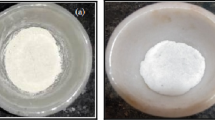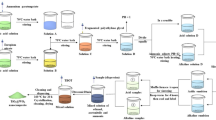Abstract
Nanomaterials are synthetized by aniline with different contents of WO3 nanoparticles using a chemical oxidative polymerization method. FTIR, ultraviolet–visible, XPS, SEM, and XRD confirmed the successful synthesis of the three PANI@WO3 samples. Thermogravimetric analysis shows an improved thermal stability by the presence of WO3 in nanocomposites compared with PANI. Interestingly, the analysis of the band gap shows lowest value of optical band gap of 1.88 eV for PANI@WO3 (0.5) compared with PANI@WO3 (1.0) and PANI@WO3 (1.5) with 1.91 eV and 1.98 eV, respectively. In addition, the electroactivity properties were investigated by cyclic voltammetry to explore the benefits of these types of hybrid materials in electrochemical applications.









Similar content being viewed by others
References
Sudha JD, Pich A, Reena VL, Sivakala S, Adler HJP (2011) Water-dispersible multifunctional polyaniline-laponite-keggin iron nanocomposites through a template approach. J Mater Chem 21:16642–16650
Ozkazanc E, Ozkazanc H (2019) Multifunctional polyaniline/chloroplatinic acid composite material: characterization and potential applications. Polym Eng Sci 59:66–73
Reena VL, Pavithran C, Verma V, Sudha JD (2010) Nanostructured multifunctional electromagnetic materials from the guest-host inorganic-organic hybrid ternary system of a polyaniline-clay-polyhydroxy iron composite: preparation and properties. J Phys Chem B 114:2578–2585
Romero PG (2001) Hybrid organic-inorganic materials-in search of synergic activity. Adv Mater 13:163–174
Fusalba F, Bélanger D (2000) Electrochemical characterization of polyaniline-molybdenum trisulfide electrode in non-aqueous media. Electrochim Acta 45:3877–3883
Hasan M, Ansari MO, Cho MH, Lee M (2015) Ammonia sensing and DC electrical conductivity studies of p-toluene sulfonic acid doped cetyltrimethylammonium bromide assisted V2O5@polyaniline composite nanofibers. J Ind Eng Chem 22:147–152
Benykhlef S, Bekhoukh A, Berenguer R, Benyoucef A, Morallon E (2016) PANI-derived polymer/Al2O3 nanocomposites: synthesis, characterization and electrochemical studies. Colloid Polym Sci 294:1877–1885
Bekhoukh A, Zehhaf A, Benyoucef A, Bousalem S, Belbachir M (2017) Nanoparticules mass effect of ZnO on the properties of poly(4-chloroaniline)/zinc oxide nanocomposites. J Inorg Organomet Polym Mater 27:13–20
Chouli F, Radja I, Morallon E, Benyoucef A (2017) A novel conducting nanocomposite obtained by p-anisidine and aniline with titanium(IV) oxide nanoparticles: synthesis, characterization, and electrochemical properties. Polym Compos 38:254–260
Benyakhou S, Belmokhtar A, Zehhaf A, Benyoucef A (2017) Development of novel hybrid materials based on poly(2-aminophenyl disulfide)/silica gel: preparation, characterization and electrochemical studies. J Mol Struct 1150:580–585
Daikh S, Zeggai FZ, Bellil A, Benyoucef A (2018) Chemical polymerization, characterization and electrochemical studies of PANI/ZnO doped with hydrochloric acid and/or zinc chloride: differences between the synthesized nanocomposites. J Phys Chem Solids 121:78–84
Yamani K, Berenguer R, Benyoucef A, Morallón E (2019) Preparation of polypyrrole (PPy)-derived polymer/ZrO2 nanocomposites: effects of nanoparticles interface and polymer structure. J Therm Anal Calorim 135:2089–2100
Kouidri FZ, Berenguer R, Benyoucef A, Morallon E (2019) Tailoring the properties of polyanilines/SiC nanocomposites by engineering monomer and chain substituents. J Mol Struct 1188:121–128
Bousalem S, Zeggai FZ, Baltach H, Benyoucef A (2020) Physical and electrochemical investigations on hybrid materials synthesized by polyaniline with various amounts of ZnO nanoparticle. Chem Phys Lett 741:137095
Ouis D, Zeggai FZ, Belmokhtar A, Benyoucef A, Meddah B, Bachari K (2020) Role of p-benzoquinone on chemically synthesized nanocomposites by polyaniline with V2O5 nanoparticle. J Inorg Organomet Polym Mater. https://doi.org/10.1007/s10904-020-01508-7
Dirican M, Yanilmaz M, Asiri AM, Zhang X (2020) Polyaniline/MnO2/porous carbon nanofiber electrodes for supercapacitors. J Electroanal Chem 861:113995
Fayemi OE, Adekunle AS, Swamy BEK, Ebenso EE (2018) Electrochemical sensor for the detection of dopamine in real samples using polyaniline/NiO, ZnO, and Fe3O4 nanocomposites on glassy carbon electrode. J Electroanal Chem 818:236–249
Wei H, Yan X, Wu S, Luo Z, Wei S, Guo Z (2012) Electropolymerized polyaniline stabilized tungsten oxide nanocomposite films: electrochromic behavior and electrochemical energy storage. J Phys Chem C 116:25052–25064
Zhang J, Wang XL, Xia XH, Gu CD, Zhao ZJ, Tu JP (2010) Enhanced electrochromic performance of macroporous WO3 films formed by anodic oxidation of DC-sputtered tungsten layers. Electrochim Acta 55:6953–6958
Balaji S, Djaoued Y, Albert AS, Brüning R, Beaudoinc N, Robichaud J (2011) Porous orthorhombic tungsten oxide thin films: synthesis, characterization, and application in electrochromic and photochromic devices. J Mater Chem 21:3940–3948
Hosseini MG, Sefidi PY, Mert AM, Kinayyigit S (2020) Investigation of solar-induced photoelectrochemical water splitting and photocatalytic dye removal activities of camphor sulfonic acid doped polyaniline-WO3-MWCNT ternary nanocomposite. J Mater Sci Technol 38:7–18
Zhang R, Ning F, Xu S, Zhou L, Shao M, Wei M (2018) Oxygen vacancy engineering of WO3 toward largely enhanced photoelectrochemical water splitting. Electrochim Acta 274:217–223
Eslah S, Nouri M (2019) Synthesis and characterization of tungsten trioxide/polyaniline/polyacrylonitrile composite nanofibers for application as a counter electrode of DSSCs1. Russ J Electrochem 55:291–304
Wang SH, Shen CY, Su JM, Chang SW (2015) A room temperature nitric oxide gas sensor based on a copper-ion-doped polyaniline/tungsten oxide nanocomposite. Sensors. 15:7084–7095
Yuksel R, Durucan C, Unalan HE (2016) Ternary nanocomposite SWNT/WO3/PANI thin film electrodes for supercapacitors. J Alloys Compd 658:183–189
Kumar R, Yadav BC (2016) Fabrication of polyaniline (PANI)-tungsten oxide (WO3) composite for humidity sensing application. J Inorg Organomet Polym Mater 26:1421–1427
Eren E, Alver C, Karaca GY, Uygunb E, Oksuz AU (2018) Enhanced electrochromic performance of WO3 hybrids using polymer plasma hybridization process. Synth Met 235:115–124
Asim N, Syuhami MF, Badiei M, Yarmo MA (2014) WO3 modification by synthesis of Nanocomposites. APCBEE Procedia 9:175–180
Qaiser AA, Hyland MM, Patterson DA (2012) Effects of various polymerization techniques on PANI deposition at the surface of cellulose ester microporous membranes: XPS and electrical conductivity studies. Synth Met 162:958–967
Lia M, Zhou S (2018) α-Fe2O3/polyaniline nanocomposites as an effective catalyst for improving the electrochemical performance of microbial fuel cell. Chem Eng J 339:539–546
Sanches EA, da Silva JMS, Ferreira JMO, Soares JC, dos Santos AL, Trovati G, Fernandes EGR, Mascarenhas YP (2014) Nanostructured polyaniline emeraldine-base form (EB-PANI): a structural investigation for different neutralization times. J Mol Struct 1074:732–737
Tzou K, Gregory RV (1993) A method to prepare soluble polyaniline salt solutions-in situ doping of PANI base with organic dopants in polar solvents. Synth Met 53:365–377
Khayet M, García-Payo MC (2009) X-ray diffraction study of polyethersulfone polymer, flat sheet and hollow fibers prepared from the same under different gas-gaps. Desalination. 245:494–500
Ingham B, Chong SV, Tallon JL (2005) Layered tungsten oxide-based organic-Inorganic hybrid materials: an infrared and Raman study. J Phys Chem B 109:4936–4940
Manuel J, Salguero T, Ramasamy RP (2019) Synthesis and characterization of polyaniline nanofibers as cathode active material for sodium-ion battery. J Appl Electrochem 49:529–537
Khanna PK, Singh N, Charan S, Visawanath AK (2005) Synthesis of Ag/polyaniline nanocomposite via an in situ photo-redox mechanism. Mater Chem Phys 92:214–219
Irimpan L, Nampoori VPN, Radhakrishnan P (2008) Spectral and nonlinear optical characteristics of nanocomposites of ZnO-CdS. J Appl Phys 103:094914–094918
Segets D, Gradl J, Taylor RK, Vassilev V, Peukert W (2009) Analysis of optical absorbance spectra for the determination of ZnO nanoparticle size distribution, solubility, and surface energy. ACS Nano 3:1703–1710
Ebrahim S, Kashyout AH, Soliman M (2009) Ac and dc conductivities of polyaniline/poly vinyl formal blend films. Curr Appl Phys 9:448–454
Acknowledgments
Authors are grateful to thank the Management D.G.R.S.D.T. Algeria for providing facilities for this work and also thankful to Instituto Universitario de Materiales of Alicante University, Spain, for the availing cooperation and for the analyses support.
Author information
Authors and Affiliations
Corresponding author
Ethics declarations
Conflict of interest
The authors declare that they have no conflict of interest.
Additional information
Publisher’s note
Springer Nature remains neutral with regard to jurisdictional claims in published maps and institutional affiliations.
Rights and permissions
About this article
Cite this article
Belardja, M.S., Djelad, H., Lafjah, M. et al. The influence of the addition of tungsten trioxide nanoparticle size on structure, thermal, and electroactivity properties of hybrid material–reinforced PANI. Colloid Polym Sci 298, 1455–1463 (2020). https://doi.org/10.1007/s00396-020-04720-6
Received:
Revised:
Accepted:
Published:
Issue Date:
DOI: https://doi.org/10.1007/s00396-020-04720-6




